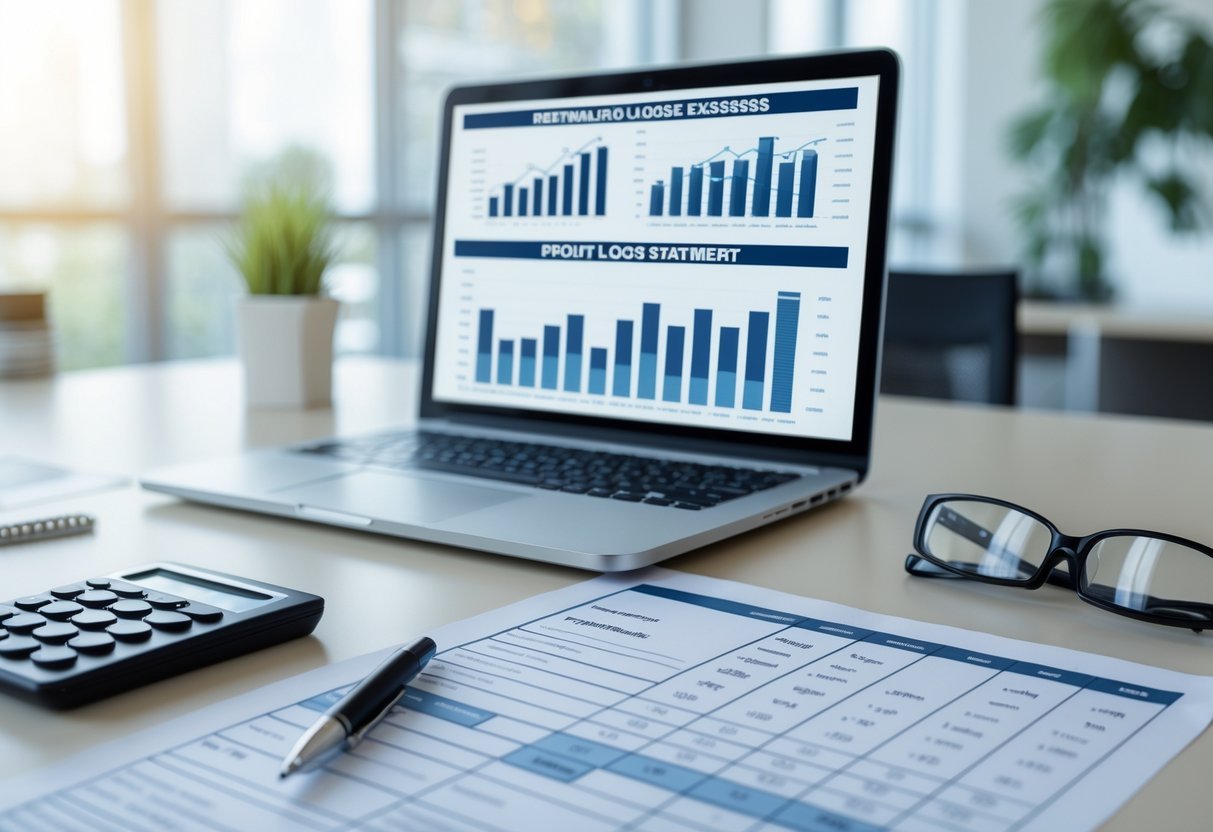Staying organized as a landlord can be challenging, especially when it comes to keeping track of your rental income and expenses. A profit and loss statement template for rental property gives you a simple way to summarize your property’s financial performance over any period. With the right template, you’ll know exactly where your money is coming from and where it’s going, making tax time much easier and giving you better insight into your investments.
Using a clear template helps ensure that you record all necessary details, such as rent received, maintenance costs, and any other expenses or sources of income. Templates are available in different formats, including Excel and Google Sheets, making it easy to find one that fits your needs, as shown by options from sites like Stessa and Coefficient.
Key Takeaways
- A profit and loss statement tracks rental income and expenses in one place.
- Using a template helps you stay organized and prepared for taxes.
- Clear instructions make it easy for landlords to manage rental property finances.
Understanding the Profit and Loss Statement Template for Rental Property
A profit and loss statement, also called an income statement, is an essential financial document for rental property owners. It details money coming in and going out, helping you measure financial performance and make informed decisions about your rental business.
Purpose and Importance
The main purpose of a profit and loss statement for rental property is to clearly show your rental income, expenses, and resulting net profit or loss. This template helps you monitor profitability each month or year.
You need this document to track cash flow and quickly spot issues or areas for improvement. Lenders, partners, and tax professionals often request up-to-date records as well.
A complete profit and loss statement provides verifiable figures needed for loan applications and tax filings. Property owners and managers use it to analyze trends, adjust budgets, and improve future performance. For more detailed background on why this document matters, see the overview at Stessa’s rental property profit and loss statement template.
Key Components
A rental property profit and loss statement template typically includes these sections:
- Rental Income: All money received from tenants, including base rent and additional fees.
- Operating Expenses: Common items such as repairs, maintenance, utilities, management fees, property taxes, and insurance.
- Net Operating Income: The difference between total rental income and total operating expenses.
- Other Expenses: Costs like mortgage interest or HOA fees.
- Net Profit or Loss: Final figure after subtracting other expenses from net operating income.
Tables often make it easier to enter and review these figures. A good rental property profit and loss template includes clear categories and space for notes or documentation.
How Profit and Loss Differs From Other Financial Documents
A profit and loss statement is different from a balance sheet and other financial reports. The profit and loss statement focuses solely on income and expenses over a specific period, showing how profitable your rental property is.
A balance sheet, by comparison, lists assets and liabilities to reveal your property’s net worth at a fixed point in time. The income statement does not show items like mortgage principal or property value—it deals only with revenues and expenses.
For tax purposes, the profit and loss is essential because it summarizes deductible expenses and reports net profit, which affects your taxable income. A simple overview of how these documents fit together can be found at Azibo’s guide to the profit and loss statement for real estate.
Detailed Breakdown of Income and Expenses
Understanding every detail of your rental property’s profits and losses requires clear tracking of what you earn and what you spend. Effective recordkeeping and accurate categorization are vital for maximizing tax deductions and gaining a full financial picture.
Tracking Rental Income and Revenues
Accurate tracking of rental income forms the base of your profit and loss statement. Each payment a tenant makes should be recorded by date, amount, and property address if you own multiple units. Include all payments, such as monthly rent, late fees, pet fees, or parking charges.
Using an Excel spreadsheet template can simplify this process and provide automated calculations of gross and net income. Back up digital records with related documents, such as leases and payment receipts, to ensure accuracy. Make a habit of updating your income records monthly to avoid errors.
Common Operating Expenses
Operating expenses are the regular and recurring costs needed to keep your property functional and attractive to tenants. These include property management fees, advertising costs for listing vacancies, maintenance and repairs, cleaning, insurance premiums, and utilities that you cover as the landlord.
It’s important to document each expense category separately to maximize write-offs. For example, you might group expenses as follows:
| Expense Category | Example Items |
|---|---|
| Advertising | Online listings, flyers |
| Maintenance/Repairs | Plumbing, electrical, supplies |
| Insurance | Fire, liability, flood |
| Property Management | Monthly fees |
| Taxes | Property taxes |
| Utilities | Water, gas, trash |
Staying consistent with your expense tracking helps you anticipate cash flow needs and reveals any business expenses that may be reduced.
One-Time and Non-Recurring Expenses
Besides regular outlays, you’ll need to track one-time and rare expenses. These can include major renovations, legal fees for evictions, or large equipment purchases. Recording these separately from operating expenses makes it easier to assess their unique impact on your profitability.
Include each non-recurring cost with as much detail as possible—such as date, reason, and amount. This distinction is useful for yearly reviews, tax filings, and evaluating return on investment. Tools like the Smartsheet profit and loss template allow you to designate separate lines for these types of expenditures.
Calculating Net Income and Gross Profit
To determine your property’s gross profit, subtract the cost of goods sold (if applicable, such as direct material or labor costs for short-term rentals) from your total rental income. Then, calculate net income by subtracting all operating and non-recurring expenses from your gross profit.
Net income reveals your rental’s true profitability after all expenses. This metric is essential for understanding cash flow and making business decisions. Many templates automatically calculate these figures, saving you time and helping you spot trends in your financial performance.
Keep your records updated and review them periodically to ensure all income and expenses are accurately reflected. This diligence supports better property management and prepares you for tax season.
Frequently Asked Questions

A profit and loss statement for rental property management gives you a clear overview of your property’s income and expenses. Using the right tools and practices helps you stay organized and supports more accurate financial reporting.
How can I create a profit and loss statement for my rental property?
To create a profit and loss statement, start by gathering rental income records and receipts for all expenses associated with your property. Input each item into a spreadsheet or accounting tool.
Calculate your total income and subtract your total expenses. The difference represents your net profit or loss for the chosen time period. You can find more detailed guides on sites that cover how to create a rental property income statement.
What should be included in a rental property profit and loss statement?
Include all sources of rental income, such as monthly rent or pet fees, as well as all relevant expenses. Typical expenses are mortgage interest, property taxes, insurance, repairs, maintenance, and utilities if the landlord pays.
Other costs may include property management fees, advertising, and legal fees. Your statement should present both total income and a breakdown of each expense type to provide a complete financial picture.
Are there free templates available for rental property profit and loss statements?
Free templates are available online and can be downloaded to simplify recordkeeping. These templates are designed for easy use and typically include fields for listing income, various expenses, and a calculation for total profit or loss.
You can find one example of a profit and loss statement template for rental property that is ready to fill out.
Can you use Excel to manage a rental property’s profit and loss?
Excel is a useful tool for tracking your rental property income and expenses. You can set up your own spreadsheet or use a pre-made rental property P&L template to save time.
Use formulas in Excel to automatically calculate totals and generate summaries. This lets you quickly see your profit or loss by month, quarter, or year.
What are the best practices for tracking profit and loss in rental property management?
Record every income and expense transaction as soon as it happens to reduce errors. Keep digital or paper copies of receipts to support your entries.
Separate your personal and rental property finances by using dedicated bank accounts. Regularly review your statement for accuracy and address discrepancies right away.
How often should I update my rental property profit and loss statement?
Update your statement at least once a month to maintain accurate financial records. Monthly updates help you catch errors early and make tax preparation easier.
Reviewing your profit and loss on a regular schedule keeps you aware of your property’s performance and supports better decision-making throughout the year.




